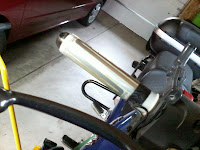Luckily I had a set of RIVCO tipover bars from Murph's Kits protecting her.

You can see the damage from the bike as the FedEx truck pushed by bike along on its side for 5 or 6 feet.
The mirrors and other extremities were protected from serious damage by the tipover bars.
So now I have a project to get the mounts replaced or repaired.
As I got the bars off to inspect the mounts that day, I immediately reviewed my options to ge thte bars replaced. Murph's Kits was my first stop to see if bars were in stock. Since they were, I ordered a set to have on hand should they be needed.
My insepction revealed the mount was badly twisted but the bars on each side were intact with some abrasions. Whew! What great durability!
After contacting RIVCO's sales department with my story in January, they were so impressed that they found a spare parts kit for me. And I was even able to meet them at the Chicago verison of the Progressive Motorcycle show to pick the kit up in person.I read now that Murph's is offering the tipover bar parts kit also.
Let's compare the original parts on the right with the replacements on the left.

The original mount 'S' piece is rather twisted by the force of the impact. The collar on the bolt is squashed. And the bolt itself is bent but did not break.
The mounting brackets are not straightforward to place. You have to mount your mid fairing to get the clearance just right. I chose to get blue Loctite on the bolts to keep them there.
And the undersides of each tipover bar were scuffed up, one side by the pavement, the other bar fought off the delivery truck.


A bit of engine touchup paint gave each of the bars a new finish. Not as glossy as new bars but cleaned up.





















































